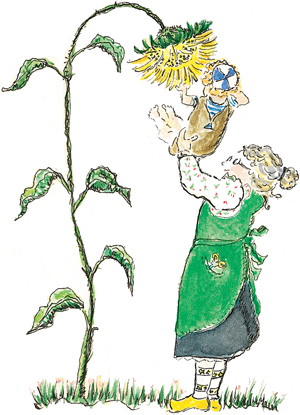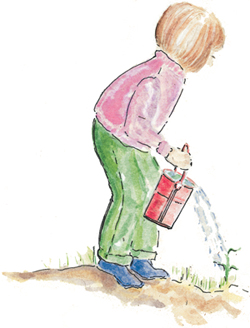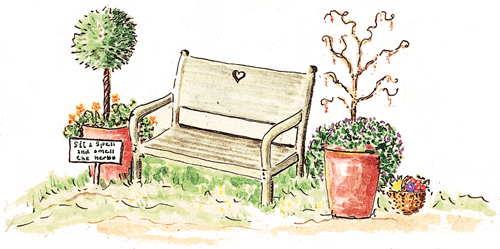

My life’s work is deeply rooted in the soil of two sunny California gardens. The first, the garden of my childhood, is where I shared the world of nature with my grandmother. She knew that the surest way to destroy the enthusiasm of a young gardener was to dictate a steady regimen of rules and routine. Instead, we greeted each day as an adventure and learned to look for and expect miracles. The second, Heart’s Ease, my community garden of the last decade, is a small, thriving plot of ground that attracts thousands of visitors annually. Both gardens, though separated by years and miles, nurture the same underlying theme: All knowledge is rooted in wonder, and what better place to cultivate wonder than in our own gardens?
When my son, Noah, was born, I started viewing the world of the garden through his thoughtful, cinnamon-brown eyes. He saw, sniffed, and heard things that had been lost to me somewhere between my childhood and growing up. As we gardened together I taught him how to separate crowded root balls and plant cuttings of scented geraniums. He taught me to listen to the crackling, firelike voices of the cottonwoods, to look at the kitty faces in Johnny-jump-ups, and to smell the faint scent of vanilla in the white heliotrope.

We both learned that the only rule we could count on in our daily garden experiences was that there are no rules; the only thing we could predict about Mother Nature is that she is unpredictable. So, every adventurous, unpredictable day in the garden was exciting and crowded with a kaleidoscope of sensory pleasures and the forgotten childhood miracles we found in unexpected places.
A decade ago my family’s herb business moved into a tiny, tumbledown cottage and barn on a quarter of an acre of land in the heart of the village of Cambria-Pines-By-The-Sea. My dream for our new land was to recreate the old-fashioned gardens of my childhood and share the magic with townsfolk, tourists, and the myriad critters flying or ambling over our scrap of earth: I saw the promise of the soil and envisioned a tapestry of leaves and flowers; my husband and son had visions of wheelbarrow loads of soil and manure and the backbreaking relocation of tons of rocks.

I knew from experience the frustration of visiting perfect gardens of grandiose proportions and design. I wanted a garden composed of lots of ideas that would easily translate to small garden spaces, balconies, window boxes, or cramped, suburban yards. I wanted do-able, earth-friendly habitats that would inspire visitors to try it for themselves at home, wherever they might live. What I wanted most was a garden where grown-ups would include their children, because gardening together is one way to get back in touch with the earth and one another.

The Heart’s Ease garden is now nearly fourteen years old. Through the years it has grown to cover every inch of available land, wall, and trellis with its unexpected beauty. It has spilled over the fences with an exuberance of greenery that has spurred us to develop two new. “idea” areas—a garden totally devoted to projects for children and a native habitat garden that effectively demonstrates our earth-friendly practices.
Our gardens have become inextricably bound to the lives of thousands of visitors and a loyal group of locals who use them as both a picnic area and a learning center. School groups meet for art classes and nature classes, the 4-H girls learn about beneficial insects and propagation, and geriatric groups gather for garden walks. Every November we host a Rosemary Festival and in April we have a Faerie. Festival replete with singing trees and scarecrows dressed like faeries. The gardens have sheltered families holding memorial services for loved ones and young couples sealing their marriage vows. A recent letter of appreciation said, “I wanted to thank you for the respite and peace absorbed from just sitting in your gardens many, many times during several years of stress. I’ve used the bench at the rear as a place to regain some stability in the midst of beauty. Without knowing it, you have given me an important gift.”
As the gardens spread and flourished, my son grew up and turned from flowers to football. Forgetting my own straying from the path at that age, I gave up hope and considered him one of the lost souls separated from the important simple pleasures and gifts of the earth.
One afternoon, after Noah had left home to attend college in a small city south of Cambria, he called and asked me to drop by for a visit. When I arrived, he whisked me out the back door to a yard that hadn’t seen the blades of a mower in months. I grimaced and quietly followed him to a flat, sunny area where a dark rectangle of soil was shining through the unruly grass. We bent over the patch and, Noah pointed to some tiny shoots just poking through the crust of earth. “Look, Mom, I planted a moonlight garden. It will be full of sweet-smelling white plants that will glow in the darkness and attract sphinx moths like the big ones we used to watch at night.”
My eyes fogged under my dark glasses. I know I grinned like a fool as we discussed the promise of the newly dug earth, and I marked my mental scorecard with a “V” for victory for Mother Earth.
This book is my invitation to you to celebrate the earth with a child, to take the time to garden together, and to take journeys in your own backyard. Remember always that your child’s knowledge will spring from the roots you planted deeply in the fertile soil of wonder.
